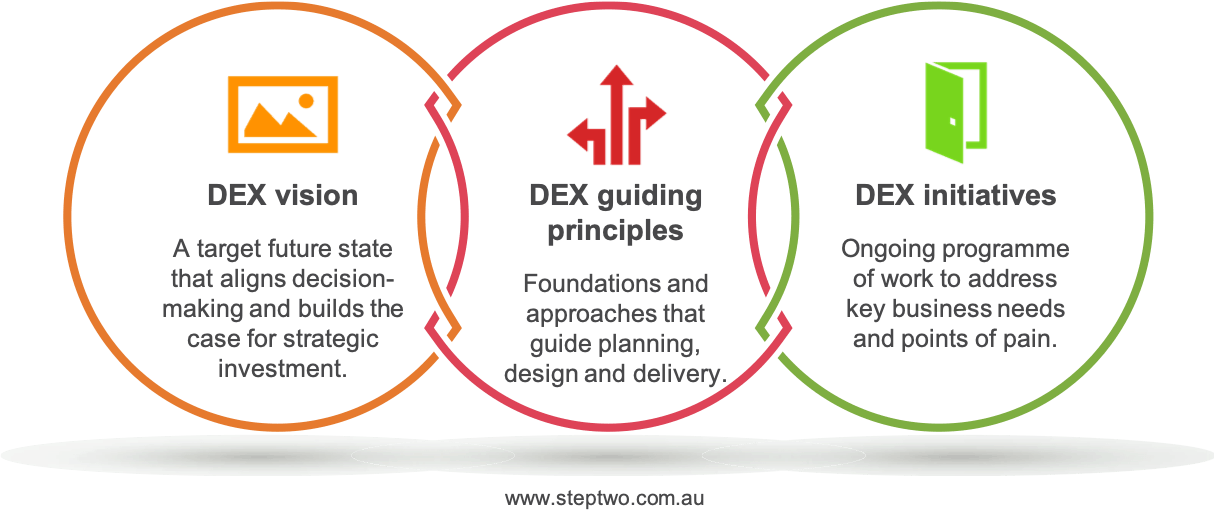
Filed under: Digital employee experience
Digital employee experience (DEX) is a holistic concept that considers not just what’s delivered to employees, but how it all fits together into a coherent experience. By its nature, this is a strategic concept, on par with customer experience and digital transformation.
While the broad scope gives DEX power, it also makes it hard to know where to start, and “how to eat the elephant”. What’s needed is a framework for tackling DEX that brings the organisation together, and ensures that every project is making a positive impact on employee experience.

Three elements for delivering DEX
Drawing on our work as consultants, we see three elements that need to be put in place to deliver a great DEX:
- a powerful DEX vision and strategy that aligns thinking across the organisation
- clear DEX guiding principles that inform decisions and designs
- an ongoing series of DEX initiatives to make a concrete impact on how employees work
Each of these is explored below.
1. DEX vision and strategy
The foundation for any meaningful strategy is a clear vision of where the organisation needs to get to. In the context of DEX, this vision must articulate in concrete terms the desired employee experience, outlining how digital tools and platforms fit together.
In most cases, the most powerful way of articulating a DEX vision is using narrative. This could consist of personas that outline the challenges and needs of key staff cohorts. It could also consist of a ‘day-in-the-life’ story, such as that outlined in A week in the digital workplace. In both cases, it’s crucial that the narrative describes the desired future state, not just the current situation, while ensuring that what’s outlined is achievable within 3-4 years (as opposed to a 10-year ‘sci-fi’ vision).
A concrete strategy then outlines how to reach the desired future state, in terms of strategic recommendations and directions. Together with the vision, the strategy must strongly make the case for large-scale business investment in delivering great digital employee experiences, alongside customer experience (CX) initiatives.
2. DEX guiding principles
Over time, projects and business areas will make countless decisions that impact on the digital employee experience, either positively or negatively. Many design decisions will also be made, both large and small.
These groups can’t all be expected to be deeply immersed in DEX, nor will they automatically make changes that improve DEX. To help shape the holistic experience, what is needed is a set of guiding principles for digital employee experience.
These may be as straightforward as “simplify the employee experience”, or more nuanced, such as “target key moments of truth for employees”.
What’s crucial is that these principles are articulated in a way that is meaningful to a wide internal audience, and that the process of defining them creates broad consensus. As they become more tangible over time, they should also be incorporated into project delivery methodologies, alongside technology assessment and change management planning.
In this way, solutions and platforms will all head towards a coherent and productive digital employee experience, even if this will be a lifelong journey.
3. DEX initiatives
Organisations are packed with legacy systems and clunky user experiences. Adding new tools alongside old ones doesn’t automatically make things better – instead they can add additional complexity.
For these reasons, there will need to be an ongoing program of DEX projects and initiatives. Operating at both large and small scales, these projects should tackle specific business needs or points of pain for employees, delivering concrete outcomes in terms of functionality or experience.
Such projects could include straightforward activities such as restructuring the knowledgebase for call centre staff, or be more ambitious, such as creating a new mobility experience that integrates multiple business systems.
Often “filling the gaps”, these activities would run alongside other projects, seeking to improve outcomes for all rather than competing with other projects.
Customer experience again projects a template for how this would work, with better customer outcomes coming from 5+ years of hard work.
Put shape around DEX
The only way to eat the elephant is one bite at a time. There cannot be a single DEX project that meets all needs and solves all problems. Instead, there will need to be widespread alignment across the business, to ensure that digital employee experience is substantively improved over time.
Have a clear vision, establish guiding principles, and then get stuck into tangible projects to make DEX better. Onwards!





